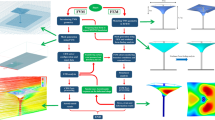Abstract
High-confinement mode is a very prominent operation style for future fusion device due to its unique advantages. However, the conjuncted edge localized modes (ELMs) are very difficult to control so that divertor plates are very prone to suffer both stationary high heat flux (HHF) loads of long-pulse operating mode and transient shock loads of ELMs. Most previous researches focus on degradation of plasma facing material (PFM), however, as a layer joining PFM and cooling tube, the soft copper interlayer suffers concentrated thermal stress loads due to mismatched thermal expansion of PFM and cooling tube. Its thermal fatigue behavior under such coupled loads is also of great significance to structural safety of divertor component. With such a motivation, the reduction effects on fatigue life time of a typical interlayer of monoblock divertor under series of coupled HHF and ELMs shock loading conditions are investigated. It is found that: (1) The transient shock feature of ELMs loading is propagated into interlayer with less sharp pattern. The increase of damage induced by coupled ELMs loading is limited in single cycle, while the accumulated damage of multiple consecutive coupled loading cycles is increased nonlinearly. (2) Under the coupled HHF and ELMs loading, the fatigue life time of interlayer is generally decreasing. The magnitude of decrease is increasing nonlinearly with the magnitude of ELMs peak and averaged heat flux. (3) For three characteristic parameters of ELMs shock loading such as frequency, duration and peak heat flux, the peak heat flux and frequency are two parameters more sensitive to determine coupled reduction effects on fatigue lifetime of the interlayer, while for high frequency case, time averaged heat flux takes the lead.








Similar content being viewed by others
References
Abaqus theory manual (v6.1), Hibbitt, Karlsson and Sorensen, Inc., US, 2010
J. Aktaa, R. Schmitt, High temperature deformation and damage behavior of RAFM steels under low cycle fatigue loading: experiments and modeling. Fusion Eng. Des. 81(19), 2221–2231 (2006)
G. Arnoux, B. Bazylev, M. Lehnen et al., Heat load measurements on the JET first wall during disruptions. J. Nucl. Mater. 415(1), S817–S820 (2011)
Crescenzi F., Moriani A., Roccella S., Visca E., Richou M., Water-cooled divertor target design study CuCrZr/W monoblock concept, EFDA Report: WP13-DAS02-T02-D02, 2013
J.W. Davis, P.D. Smith, ITER material properties handbook. J. Nucl. Mater. 233(Part 2), 1593–1596 (1994)
G. Dell’Orco, P. Lorenzetto, A. Malavasi et al., Thermal–mechanical test on ITER primary first wall mock-ups. Fusion Eng. Des. 61, 117–122 (2002)
T. Hirai, K. Ezato, P. Majerus, ITER relevant high heat flux testing on plasma facing surfaces. Mater. Trans. 46, 412–424 (2005)
J.H. You, H. Bolt, Analytical method for thermal stress analysis of plasma facing materials. J. Nucl. Mater. 299(1), 9–19 (2001)
M. Lehnen, G. Arnoux, N. Hartmann et al., Disruption heat loads and their mitigation in JET with the ITER-like wall. J. Nucl. Mater. 438, S102–S107 (2013)
J. Linke, M. Akiba, H. Bolt, Performance of beryllium, carbon, and tungsten under intense thermal fluxes. J. Nucl. Mater. 241, 1210–1216 (1997)
M.Y. Li, E. Werner, J.H. You, Low cycle fatigue behavior of ITER-like divertor target under DEMO-relevant operation conditions. Fusion Eng. Des. 90, 88–96 (2015)
Q. Li, X. HE, Surface damage of tungsten during plasma disruption. J. Hefei Univ. Technol. (Nat. Sci.) 10, 1181–1183 (2008)
M. Wirtz, J. Linke, G. Pintsuk, Thermal shock behaviour of tungsten after high flux H-plasma loading. J. Nucl. Mater. 443(1), 497–501 (2013)
Z. Sun, Q. Li, W. Wang, J.-C. Wang, X. Wang, R. Wei, C. Xie, G. Luo, T. Hirai, F. Escourbiac, S. Panayotis, Post examination of tungsten monoblocks subjected to high heat fluxtests of ITER full-tungsten divertor qualification program. Fusion Eng. Des. 121, 60–69 (2017)
J.-H. You, M. Miskiewicz, Material parameters of copper and CuCrZr alloy for cyclic plasticity at elevated temperatures. J. Nucl. Mater. 373, 269–274 (2008)
Y. Igitkhanov, B. Bazylev, Modeling of DEMO PFC erosion due to ELM Impact. IEEE Trans. Plasma Sci. 42(9), 2284–2290 (2014)
Acknowledgements
This work is supported by the National Magnetic Confinement Fusion Science Program of China under Grants Nos. 2015GB121007 and 2013GB113004.
Author information
Authors and Affiliations
Corresponding author
Rights and permissions
About this article
Cite this article
Huang, S., Liu, S. Numerical Analysis of Fatigue Behavior of ITER-Like Monoblock Divertor Interlayer Under Coupled Heat Loads. J Fusion Energ 37, 177–186 (2018). https://doi.org/10.1007/s10894-018-0164-3
Published:
Issue Date:
DOI: https://doi.org/10.1007/s10894-018-0164-3




